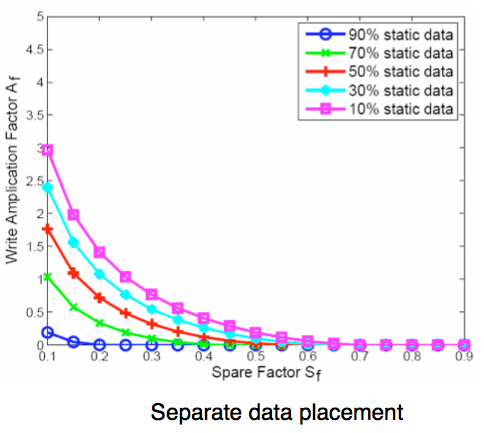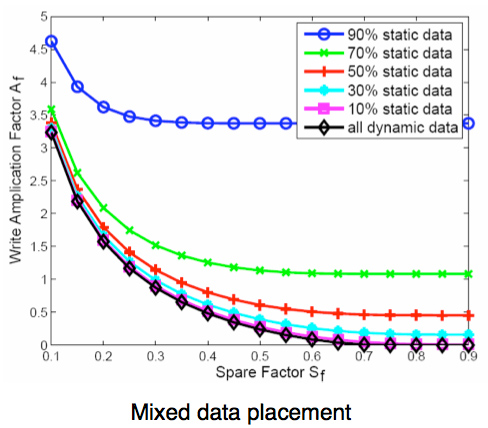The SSD Relapse: Understanding and Choosing the Best SSD
by Anand Lal Shimpi on August 30, 2009 12:00 AM EST- Posted in
- Storage
The Instruction That Changes (almost) Everything: TRIM
TRIM is an interesting command. It lets the SSD prioritize blocks for cleaning. In the example I used before, a block is cleaned only when the drive runs out of places to write things and has to dip into its spare area. With TRIM, if you delete a file, the OS sends a TRIM command to the drive along with the associated LBAs that are no longer needed. The TRIM command tells the drive that it can schedule those blocks for cleaning and add them to the pool of replacement blocks.
A used SSD will only have its spare area to use as a scratch pad for moving data around; on most consumer drives that’s around 7%. Take a look at this graph from a study IBM did on SSD performance:

Write Amplification vs. Spare Area, courtesy of IBM Zurich Research Laboratory
Note how dramatically write amplification goes down when you increase the percentage of spare area the drive has. In order to get down to a write amplification factor of 1 our spare area needs to be somewhere in the 10 - 30% range, depending on how much of the data on our drive is static.
Remember our pool of replacement blocks? This graph actually assumes that we have multiple pools of replacement blocks. One for frequently changing data (e.g. file tables, pagefile, other random writes) and one for static data (e.g. installed applications, data). If the SSD controller only implements a single pool of replacement blocks, the spare area requirements are much higher:

Write Amplification vs. Spare Area, courtesy of IBM Zurich Research Laboratory
We’re looking at a minimum of 30% spare area for this simpler algorithm. Some models don’t even drop down to 1.0x write amplification.
But remember, today’s consumer drives only ship with roughly 6 - 7% spare area on them. That’s under the 10% minimum even from our more sophisticated controller example. By comparison, the enterprise SSDs like Intel’s X25-E ship with more spare area - in this case 20%.
What TRIM does is help give well architected controllers like that in the X25-M more spare area. Space you’re not using on the drive, space that has been TRIMed, can now be used in the pool of replacement blocks. And as IBM’s study shows, that can go a long way to improving performance depending on your workload.










295 Comments
View All Comments
Anand Lal Shimpi - Monday, August 31, 2009 - link
Maybe I should compile these things into a book? :)Here are my answers about some stuff:
1) There's a spec for how hard drive makers report capacity. They define 1GB as 1 billion bytes. This is technically correct (base 10 SI prefix as you correctly pointed out). The HDDs also physically have this much storage on them, they are made up of sequentially numbered sectors that are easily counted in a decimal number system.
All other aspects of PC storage (e.g. cache, DRAM, NAND flash) however work in base 2 (like the rest of the PC). In these respects 1GB is defined as 1024^3 because we're dealing with a base 2 number system. There are reasons for this but it goes beyond the scope of what I'm posting :)
Intel adheres to the same spec that the HDD makers use. But the X25-M is made up of flash, which as I just mentioned is addressed in a base 2 number system. There's more flash than user space on the drive, it's used as spare area, woohoo. I think we're both on the same page here, just saying things differently :)
2) We'll see a 320GB drive, just not this year. I don't know that the demand is there especially given the weak economy.
Dreams do sometimes come true... ;)
3) Perhaps, but I don't like the idea of a drive doing anything but idling when it's supposed to be...idle. This does funny things to notebook battery life I'd think.
4) This is true. There's also another thing you can do with the jumper (and perhaps some additional software): flash any indilinx drive with any firmware regardless of vendor :)
5) I had to throw out a lot of data because of variations between runs. It ended up being a combination of immature drivers, immature benchmarks and some OS trickery. The setup I have now is very reliable and provides very repeatable results with very little variation. While I run everything three times, the runs are so close that you could technically do only one run per drive and still be fine.
6) I wouldn't count WD and Seagate out just yet. It may take them a while but they won't go quietly...
7) Samsung makes a ton of money from SSD sales to OEMs, they don't seem to care about the end user market as much. If end users start protesting Samsung drives however, things will change.
In my opinion? Once Apple falls, the rest will follow. If Apple will migrate to Intel (possible) or Indilinx (less likely), we'll see the same from the other OEMs and Samsung will be forced to change.
Or I could be too pessimistic and we'll see better performance from Samsung before then.
8) Agreed :)
I'll finish here too :)
Take care,
Anand
Reven - Monday, August 31, 2009 - link
Anand, dont listen to the guys like blyndy who diss on the anthologies, I love them. You can find a basic review anywhere, its the in-depth yet simple to understand stuff like these anthologies that make me visit Anandtech all the time.Keep it up, dude!
Anand Lal Shimpi - Monday, August 31, 2009 - link
Thank you :)EasterEEL - Monday, August 31, 2009 - link
I have a couple of questions regarding the Intel® SATA SSD Firmware Update Tool (2832KB) v1.3 8/24/2009.Does this firmware enable TRIM within the SSD to work with Windows 7?
If AHCI is enabled in the BIOS (but not RAID) does Windows 7 use it's own drivers with TRIM? Or does it load Intel’s Matrix Storage Manager driver which does not support TRIM as per the article note below?
"Unfortunately if you’re running an Intel controller in RAID mode (whether non-member RAID or not), Windows 7 loads Intel’s Matrix Storage Manager driver, which presently does not pass the TRIM command. Intel is working on a solution to this and I'd expect that it'll get fixed after the release of Intel's 34nm TRIM firmware in Q4 of this year."
Anand Lal Shimpi - Monday, August 31, 2009 - link
That update does not enable TRIM. The TRIM firmware is in testing now and it will be out sometime in Q4 of this year (October - December).If AHCI is enabled in the BIOS and you haven't loaded Intel's MSM drivers then it will use the Windows 7 driver and TRIM will be supported.
Take care,
Anand
uberowo - Monday, August 31, 2009 - link
I do have a question however. :DI am building a gaming pc, and I am buying ssd disk/s. Would I benefit from getting 2x80gb intel gen2s and using raid0? Or should I stick with a single 160gb?
Anand Lal Shimpi - Monday, August 31, 2009 - link
While I haven't tested 2 x 80GB drives in RAID-0, my feeling is that a single SSD is going to be better than two in RAID going forward. As of now I don't know that anyone's TRIM firmware is going to work if you've got two drives in RAID-0.The perceived performance gains in RAID-0 also aren't that great on SSDs from what I've seen.
Take care,
Anand
Ardax - Monday, August 31, 2009 - link
A naive guess would be that it depends on the workload. For lots of sequential transfers a RAID-0 should shine -- particularly on reads -- because you're spreading the transfers out over multiple SATA channels.Losing TRIM is a problem. Finding a controller than can handle the performance is entirely likely to be another.
uberowo - Monday, August 31, 2009 - link
Thanks a lot for taking the time to answer. Not to mention making this awesome site. :)Anand Lal Shimpi - Monday, August 31, 2009 - link
You guys take the time to read it and make some truly wonderful comments, it's the least I can do :)-A